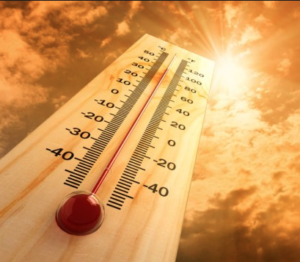It’s hot out there. Watch your plants for heat stress.
We gardeners, can walk under a shade tree or into the air conditioning and drink a cool glass of water, but our plants don’t have these conveniences. The effects of heat on plants can be manipulated to some degree with shade and water but  eventually
eventually
just have to accept that we live in a region that often gives us harsh hot summers.
For many plants, heat stress occurs when temperatures rise to about 95 degrees Fahrenheit, most plant tissue begins to die when temperatures reach about 115 degrees. We can get pretty close to that here in Saint Louis.
Fortunately plants have a couple of ways to cool themselves when the temperatures rise. Their main mechanism for cooling is transpiration. In simple terms, transpiration is the plant releasing water it takes up through small pores on leaves and stems to cool itself. Transpiration also acts as a siphon to bring up more water carrying nutrients. This is greatly reduced if the soil is dry because the plant will close the pores to conserve moisture, which can lead to overheating because they can’t dissipate that heat out in the air. Wind cooling is another way to reduce heat build up in plants. Leaves can also radiate out heat, as they are usually a degree or two above air temperature but when the temps get really high, watch out, this slows dramatically as does transpiration, photosynthesis and many other normal plant functions.
About 11am to about 5pm is when we really need to worry on hot days. Our humidity in Saint Louis can be oppressive, but without it our extreme summer temperatures would kill many more plants. So keep in mind that that humidity coupled with our heat actually allows us to grow many more things than other areas that are just plain hot.
The worst conditions we face are hot dry winds and radiated heat from buildings and concrete. Long periods of high night temperatures are also hard and morning watering becomes very important during these times.
Expect to see scalding and scorching and sunburn on leaves and stems, leaf death or drop, growth slowdown and death when heat stress leads to injury. Wilting is usually your first indicator that there is water loss and overheating. Some plants, especially trees and shrubs will drop leaves in an attempt to conserve water
We can overcome the worst of these conditions if we can give our plants overhead water with a sprinkler or mister. This will reduce the temperature of the plant tissue and improve water supply. Mulch is a great way conserve moisture and also reduce radiant and reflective heat. I have even put a white bed sheet down around containers I had sitting in full sun on asphalt on the hottest days. Shade cloth is another way to reduce radiation and temperature but is mostly used in settings where crops (or like me, bonsai) are grown. So keep an eye on your plants for summer heat stress and stay cool!
